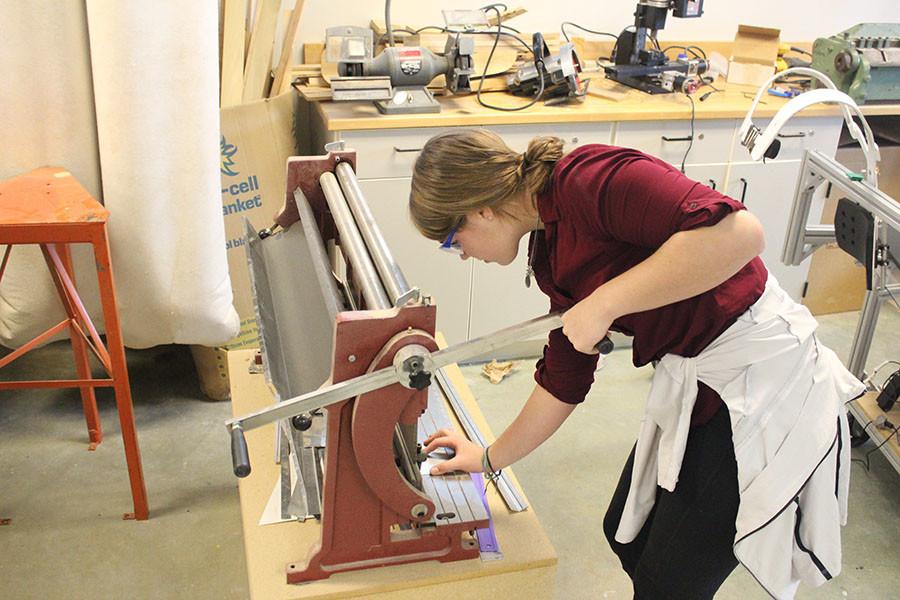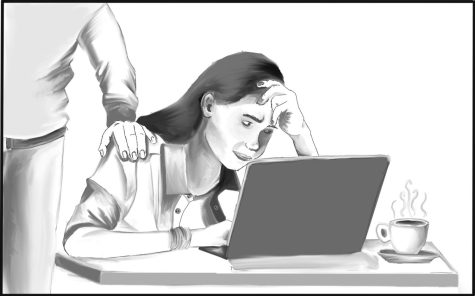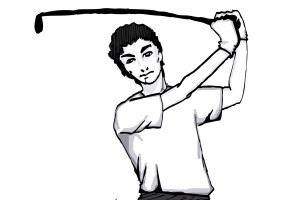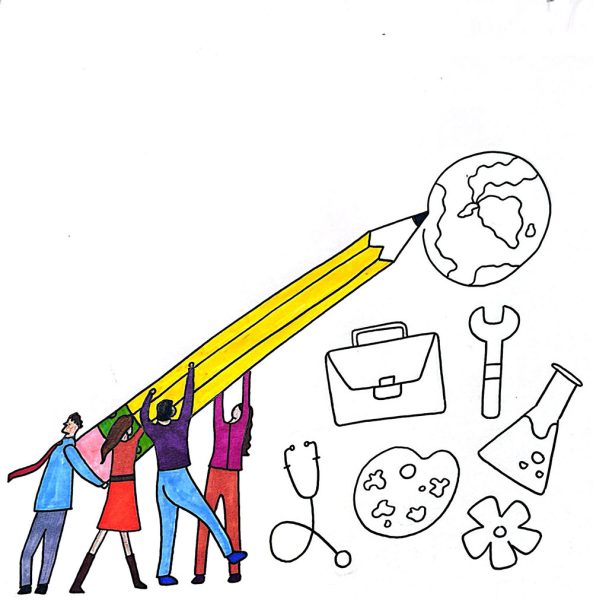Breaking the Glass Beaker
At BHS and nationwide, women are lacking in upper-level STEM classes
When math teacher Jessica Kellogg arrived at her upper level college math classes, she knew she was in a man’s world. Her teachers were male; her peers were male; even the tutors at the support center were male.
“I felt like you had to really earn your way to show you belonged there–more than the guy who signed up for the class,” Kellogg said.
The gender imbalance Kellogg felt in her classes is just one example of an issue both nationally and right here at BHS: the low numbers of women in STEM (science, technology, engineering, and math) classes, degree programs and careers.
At BHS, some, though certainly not all, of the AP, honors and elective science and math offerings are majority male. These include AP Calculus BC, AP Chemistry, Honors Robotics, AP Physics C, AP Computer Science, Software Engineering and all of the three Design & Engineering classes.
These statistics reflect larger national trends. Nationally, each of these AP exams is male-dominated. Moreover, according to the 2010 census, while women make up half of the workforce, they only comprise 26% of STEM employees.
The lack of women in upper level BHS classes can have a direct effect on career paths later on. According to a study Xueli Wang of the University of Wisconsin-Madison, intention to major in STEM is directly affected by 12th grade math achievement. Significantly, the number and level of math and science classes taken in high school is directly correlated with intention to major in STEM.
Given the influence high school math and science courses seem to have in later decisions, it is important to understand why these inequalities exist in BHS classrooms and how to mitigate them. A Beachcomber investigation has found a confluence of factors including stereotypes, a lack of confidence and a large number of AP courses offered may all produce this gender gap-a microcosm of the STEM world in our very halls.
Discrepancies in the Upper levels
Approximately equal numbers of male and females take advanced and honors math courses at the elementary and middle school levels, according to K-12 Math Coordinator and AP Calculus BC teacher Carole Katz. It is in the highest echelons where inequalities appear.
“It seems that although we have of plethora of females in our honors classes, when we add the additional [honors classes], there are fewer [females],” Katz said.
Data provided by Principal Dr. Ed Klein confirms this statement. For the past three years, AP Calculus BC has been less than a third female. While there are only five students in AP Chemistry, there is only one female, and last year, only one of eight students was a woman.
There is a similar pattern in AP Computer Science, Software Engineering, and Honors Robotics are all small classes with very few women. According to AP Computer Science and Software Engineering teacher John Kaminiski, each class is comprised of 7 and 8 males, respectively, and none are female. However, Kaminksi noted that last year, about 20% of his AP Computer Science class was female. Similarly, two of the five students in Honors Robotics this year are women but last year, only one female of eight students took the class, and two years ago, eight men were enrolled.
According to physics teacher Michael Lerner, there is only one female in the twelve-person AP Physics C class. However, while in the past AP Physics B was male dominated, this year, there are more girls boy in the similar AP Physics 1&2 (6 boys to 8 girls).
While Intro to Design and Design I can be classified better as electives than upper-level courses, enrollment figures provided by teacher Chris Croftcheck reveal similar inequities. Of the 33 people in his Intro to Design class, four are girls, and his Design I class, there is only one girl to eleven boys.
However, these discrepancies do not exist at the lower levels. Honors Biology, Honors Algebra 2, and Honors Geometry have had a nearly 50/50 divide between the sexes over the past three years. All of these courses are typically taken by sophomores and freshmen. Junior and senior year students begin to specialize, and it would appear, for the most part, females are not choosing to specialize in math and science. (However, these discrepancies do not exist in AP Biology, and AP Environmental Science has been female dominated).
Stereotyping
Women may choose not to take upper level STEM classes because a stereotype that men are better in these fields. A 2012 study by Good, Rattan and Dweck in The Journal of Personality and Social Psychology found that one factor that made women feel they did not belong in the mathematics field was the stereotype that boys are better at math. BHS teachers and students said that they had encountered this stereotype.
“If you look in a movie, you see a man: geeky, wearing high pants. That’s the stereotypical computer programmer…It’s put into these girls’ heads that they can’t do it,” said senior Maya Peleg, whose senior research paper focused on the lack of women in STEM fields. Peleg has taken several honors and AP math and science courses, is a member of the robotics team, and is planning on pursuing the sciences in college and after.
“It’s part of the culture of the genius scientist: the brilliant genius white male scientist that you see again and again in both history and movies,” Lerner said.
It is not clear the extent to which BHS girls are affected by these stereotypes. However, it is clear that students are at least aware of these norms.
“Physics is obviously a male thing and I think that’s partially a reason not many girls go there because this general feeling in society,” senior Janet Wang said. However, this has not stopped Wang; she is the only girl in AP Chemistry and AP Physics C and one of a minority in AP Calculus BC.
“I think there is another stereotype that men might be smarter than women. I think that mentality might add to why some females or girls feel like ‘Oh, I’m not as good as this because I’m not math-minded, I’m not science minded, let’s leave that to the men,’” Kellogg said.
Sometimes these stereotypes can manifest themselves in the classroom. I guess in physics guys will be guys: dumb some of time. Sometimes they’re like ‘Hahaha, women in the kitchen, hahaha’,” Wang said. However, she said she did not feel uncomfortable or discriminated against in the classroom. Indeed, three other girls interviewed for this article said they had not encountered sexism directly in their honors or AP classes.
However, research is finding that there is no neurological basis for the perception that men are more talented than women at math and science. A recent study by David Miller of Northwestern University and Diane Halpern of Claremont McKenna College showed that certain neurological differences believed to make women more “verbal” and make men more “spatial” or mathematics-oriented are untrue.
Lack of Confidence
According to a study by Leslie, Cimpian, Meyer and Freeland in the journal Science, there are fewer women doctoral students in fields where innate ability or “brilliance” is felt by many as necessary to be successful. These fields include math, physics, computer science and math. Moreover, the Good, Rattan and Dweck study cited earlier found that the perception that innate ability was a requirement for success made women feel like they did not belong in the mathematics field. Essentially, when the scientific community feels natural brilliance is necessary for success, women feel they do have what it takes to enter the field.
This sentiment was shared by BHS female students and teachers.
Peleg says that on the robotics team, females seem to be intimidated to join and when they join, are afraid to do the more technical activities, preferring to design shirts instead of building the robot.
“Freshmen girls-they’re kind of into what I’m doing with the shirts,” Peleg said. “They say they don’t know how to do anything else.”
“The thing is the freshmen boys who are going in don’t know [how to build a robot] either,” she continued. According to Peleg, the boys seem less afraid of failure than their female counterparts.
Lerner also noticed a greater fear of failure in his female physics students.
“Boys will be wrong in a class and forget they were ever wrong, and girls will internalize it,” Lerner said.
While Lerner is not sure what leads to this difference, he did note that people feel that genius is a requirement in physics, more than other subjects.
“[Physicists] talk a lot about geniuses and smart kids,” he said. “There’s also this culture in physic classes in college where you pretend you know the answers to everything before learning the material.”
Kellogg acknowledged that this culture almost discouraged her from pursuing mathematics.
“When I was younger, I was not a genius at math,” Kellogg said. “I threw my textbook out the window; I hated math.”
“There were teachers that got me interested in it,” she said. “[They] showed me I could be good at it, [and] showed me all the doors that could be open with math knowledge.”
Solutions for the Future
The large quantity of AP classes offered at BHS makes it easy for women to fill their schedule with classes other than high level math and science.
“If a student is genuinely more interested in English, they’re not going to load up on math,” Kellogg said. “[Students] are just picking and choosing where to fill their plate.”
Katz noted that when Beachwood offered fewer AP classes, both women and men would take the highest levels as those were simply the only upper level classes to take.
However, it is undisputable that women are choosing to take into math and science classes less frequently than men.
Katz said she has suggested implementing a new AP class, called AP Computer Science Principles. The class, which has not yet been approved by the Beachwood School Board and will not be launched by the College Board until the fall of 2016, is a class aimed at participation of those who have typically not taken computer science, such as women and minorities.
“It’s very project-oriented; [the exam is] half test and half project. [Students] investigate the idea of problem solving and putting together some kind of computer program,” Katz said. “It’s gearing toward minorities and females and people who don’t normally take those sorts of courses.”
Many see encouragement from female mentors or teachers as key.
“If there are any [girls] who feel they can’t [take STEM classes], I think it would be great [if] teachers or counselors [could encourage them] or [they could] speak with a successful women in the STEM field,” junior Hannah Leland said. Leland is currently enrolled in AP Calculus BC and AP Physics 1 & 2. She plans on taking AP Physics C and more upper-level math courses next year.
Kellogg echoed this sentiment, feeling that mentoring by her female teachers was crucial to her own feelings of self-efficacy in her math classes.
“If I think about the teachers that helped me the most in [my math] classes it was female math teachers showing me you don’t have to be really good at this [innately], you can learn to be good at this,” she said.
Peleg said it might be helpful if girls are encouraged from the ground-up, by their peers who have taken the course.
“I think the students who have been through it [can] show the other girl students that they can do it and [that] they always have support,” she said.











![“My parents have always said that education is important. My parents are Chinese immigrants, I'm Chinese American, [and that's a] value that has always been ingrained in our community,” said Senior Lyndia Zheng, pictured with Tony Zheng](https://bcomber.org/wp-content/uploads/2025/10/DSC_4244-600x400.jpg)

